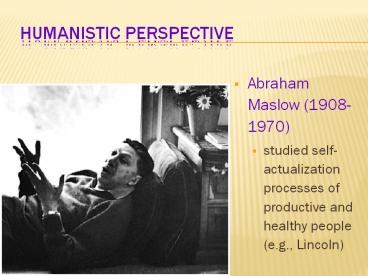Humanistic Perspective PowerPoint PPT Presentation
1 / 19
Title: Humanistic Perspective
1
Humanistic Perspective
- Abraham Maslow (1908-1970)
- studied self-actualization processes of
productive and healthy people (e.g., Lincoln)
2
Humanistic Perspective
- Self-Actualization
- the ultimate psychological need that arises after
basic physical and psychological needs are met
and self-esteem is achieved - the motivation to fulfill ones potential
3
Humanistic Perspective
- Carl Rogers (1902-1987)
- focused on growth and fulfillment of individuals
- genuineness
- acceptance
- empathy
4
Humanistic Perspective
- Unconditional Positive Regard
- an attitude of total acceptance toward another
person - Self-Concept
- all our thoughts and feelings about ourselves, in
an answer to the question, Who am I?
5
Contemporary Research-- The Trait Perspective
- Trait
- a characteristic pattern of behavior
- a disposition to feel and act, as assessed by
self-report inventories and peer reports - Personality Inventory
- a questionnaire (often with true-false or
agree-disagree items) on which people respond to
items designed to gauge a wide range of feelings
and behaviors - used to assess selected personality traits
6
The Trait Perspective
- Hans and Sybil Eysenck use two primary
personality factors as axes for describing
personality variation
7
The Trait Perspective
- Minnesota Multiphasic Personality Inventory
(MMPI) - the most widely researched and clinically used of
all personality tests - originally developed to identify emotional
disorders (still considered its most appropriate
use) - now used for many other screening purposes
8
The Trait Perspective
- Empirically Derived Test
- a test developed by testing a pool of items and
then selecting those that discriminate between
groups - such as the MMPI
9
The Trait Perspective
- Minnesota Multiphasic Personality Inventory
(MMPI) test profile
10
The Trait Perspective
11
The Trait Perspective
12
Social-Cognitive Perspective
- Social-Cognitive Perspective
- views behavior as influenced by the interaction
between persons and their social context - Reciprocal Determinism
- the interacting influences between personality
and environmental factors
13
Social-Cognitive Perspective
14
Social-Cognitive Perspective
- Personal Control
- our sense of controlling our environments rather
than feeling helpless - External Locus of Control
- the perception that chance or outside forces
beyond ones personal control determine ones fate
15
Social-Cognitive Perspective
- Internal Locus of Control
- the perception that one controls ones own fate
- Learned Helplessness
- the hopelessness and passive resignation an
animal or human learns when unable to avoid
repeated aversive events
16
Social-Cognitive Perspective
- Learned Helplessness
17
Exploring the Self
- Spotlight Effect
- overestimating others noticing and evaluating our
appearance, performance, and blunders - Self Esteem
- ones feelings of high or low self-worth
- Self-Serving Bias
- readiness to perceive oneself favorably
18
Exploring the Self
- Individualism
- giving priority to ones own goals over group
goals and defining ones identity in terms of
personal attributes rather than group
identifications - Collectivism
- giving priority to the goals of ones group
(often ones extended family or work group) and
defining ones identity accordingly
19
Exploring the Self

